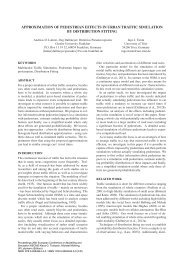Pedestrian Simulation for Urban Traffic Scenarios
Pedestrian Simulation for Urban Traffic Scenarios
Pedestrian Simulation for Urban Traffic Scenarios
You also want an ePaper? Increase the reach of your titles
YUMPU automatically turns print PDFs into web optimized ePapers that Google loves.
[3] Jörg Dallmeyer, Andreas D. Lattner, and Ingo J. Timm.<br />
From GIS to Mixed <strong>Traffic</strong> <strong>Simulation</strong> in <strong>Urban</strong> <strong>Scenarios</strong>.<br />
In Jason Liu, Francesco Quaglia, Stephan Eidenbenz,<br />
and Stephen Gilmore, editors, 4th International<br />
ICST Conference on <strong>Simulation</strong> Tools and Techniques,<br />
SIMUTools ’11, Barcelona, Spain, March 22 - 24, 2011,<br />
pages 134–143. ICST (Institute <strong>for</strong> Computer Sciences,<br />
Social-In<strong>for</strong>matics and Telecommunications Engineering),<br />
Brüssel, 2011. ISBN 978-1-936968-00-8.<br />
[4] Jörg Dallmeyer, Andreas D. Lattner, and Ingo J. Timm.<br />
Data Mining <strong>for</strong> Geoin<strong>for</strong>matics: Methods and Applications,<br />
chapter GIS-based <strong>Traffic</strong> <strong>Simulation</strong> using OSM.<br />
Cervone, Guido and Lin, Jessica and Waters, Nigel<br />
(eds.) Springer, 2012. (accepted).<br />
[5] Sanghamitra Das, Charles F. Manski, and Mark D.<br />
Manuszak. Walk or wait? an empirical analysis of street<br />
crossing decisions. Journal of Applied Econometrics,<br />
20(4):529–548, 2005.<br />
[6] K. Fitzpatrick, M. A. Brewer, and S. Turner. Another<br />
look at pedestrian walking speed. In Proceedings of<br />
the 85th Annual Meeting of the Transportation Research<br />
Board, Washington, DC, USA., 2006.<br />
[7] Dirk Helbing and Péter Molnár. Social <strong>for</strong>ce model <strong>for</strong><br />
pedestrian dynamics. Physical Review E, 51(5):4282–<br />
4286, May 1995.<br />
[8] Roger L. Hughes. The flow of human crowds. Annual<br />
Review of Fluid Mechanics, 35(1):169–182, 2003.<br />
[9] Muhammad Moazzam Ishaque. Policies <strong>for</strong> <strong>Pedestrian</strong><br />
Access: Multi-Modal Trade-off analysis using Micro-<br />
<strong>Simulation</strong> Techniques. PhD thesis, Centre <strong>for</strong> Transport<br />
Studies Imperial College London, 2006.<br />
[10] Muhammad Moazzam Ishaque and Robert B Noland.<br />
<strong>Pedestrian</strong> modeling in urban road networks: Issues,<br />
limitations and opportunities offered by microsimulation.<br />
9th Annual Computers in <strong>Urban</strong> Planning<br />
and <strong>Urban</strong> Management, London, page 9, 2005.<br />
[11] Muhammad Moazzam Ishaque and Robert B. Noland.<br />
Behavioural issues in pedestrian speed choice and street<br />
crossing behaviour: A review. In Transport Reviews: A<br />
Transnational Transdisciplinary Journal, volume 28(1),<br />
pages 61–85, Jan 2008.<br />
[12] Andreas D. Lattner, Jörg Dallmeyer, and Ingo J. Timm.<br />
Learning dynamic adaptation strategies in agent-based<br />
traffic simulation experiments. In Ninth German Conference<br />
on Multi-Agent System Technologies (MATES<br />
2011), pages 77–88. Springer: Berlin, LNCS 6973,<br />
Klügl, F.; Ossowski, S., 2011. ISBN: 978-3-642-24602-<br />
9.<br />
[13] Michele Ottomanelli, Leonardo Caggiani, Iannucci<br />
Giuseppe, and Domenico Sassanelli. An adaptive<br />
neuro-fuzzy inference system <strong>for</strong> simulation of pedestrians<br />
behaviour at unsignalized roadway crossings. 14th<br />
Online World Conference on Soft Computing in Industrial<br />
Application, 14, 2009.<br />
[14] Y. Tanaboriboon, S. S. Hwa, and C. H. Chor. <strong>Pedestrian</strong><br />
characteristics study in singapore. Journal of Transportation<br />
Engineering, 112:229–235, 1986.<br />
[15] Rainer Wiedemann. <strong>Simulation</strong> des Straßenverkehrsflusses.<br />
Schriftenreihe des IfV, 8, 1974.<br />
BIOGRAPHY<br />
Jörg Dallmeyer received the bachelor degree (2008) as<br />
well as the master degree (2009) in computer science at the<br />
Goethe University of Frankfurt am Main, Germany. Since<br />
December 2009, he is a PhD student at the chair <strong>for</strong> “In<strong>for</strong>mation<br />
Systems and <strong>Simulation</strong>” at the Goethe University<br />
Frankfurt. His research interests are actor based simulation<br />
<strong>for</strong> the field of traffic simulation under consideration of multimodal<br />
traffic and the building of simulation systems from<br />
geographical in<strong>for</strong>mation.<br />
Andreas D. Lattner received the Diploma degree in computer<br />
science at the University of Bremen, Germany in 2000.<br />
From December 2000 to March 2007 he was working as research<br />
scientist at the Center <strong>for</strong> Computing Technologies<br />
(TZI) at the University of Bremen. In 2007 he obtained the<br />
doctor’s degree <strong>for</strong> his thesis on “Temporal Pattern Mining<br />
in Dynamic Environments”. He works now as a postdoctoral<br />
researcher at the chair <strong>for</strong> “In<strong>for</strong>mation Systems and <strong>Simulation</strong>”<br />
at the Goethe University Frankfurt. His research interests<br />
include knowledge discovery in simulation experiments,<br />
temporal pattern mining, and multi-agent systems.<br />
Ingo J. Timm received Diploma degree (1997), PhD<br />
(2004) and venia legendi (2006) in computer science from<br />
University of Bremen. From 1998 to 2006, he has been PhD<br />
student, research assistant, visiting and senior researcher, and<br />
managing director at University of Bremen, Technical University<br />
Ilmenau, and Indiana University Purdue University<br />
- Indianapolis. In 2006, Ingo Timm was appointed full professor<br />
<strong>for</strong> In<strong>for</strong>mation Systems and <strong>Simulation</strong> at Goethe-<br />
University Frankfurt. Since 2010, he holds a chair <strong>for</strong> Business<br />
In<strong>for</strong>matics at University of Trier. He works on in<strong>for</strong>mation<br />
systems, knowledge-based systems in logistics and<br />
medicine. His special interests lie on strategic management<br />
of autonomous software systems, actor-based simulation and<br />
knowledge-based support to simulation systems.<br />
Acknowledgement This work was made possible by<br />
the MainCampus scholarship of the Stiftung Polytechnische<br />
Gesellschaft Frankfurt am Main.



